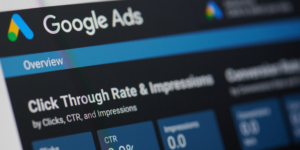The internet is an incredible place for information and connection, but it also comes with its fair share of annoyances. Among these, targeted ads from tech giants Google and Facebook often lead the way. These ads, while sometimes relevant, can quickly become invasive and disruptive.
Understanding Google Ads
Google Ads have become an integral part of the online experience, shaping the way businesses connect with potential customers and users interact with content. These ads, often tailored to individual interests, play a significant role in the revenue models of many companies. However, to effectively manage and control these ads, it’s crucial to understand the underlying mechanics of how Google Ads operate.

How Do Google Ads Work?
At the heart of Google Ads is a system known as pay-per-click (PPC) advertising. Advertisers bid on specific keywords that are relevant to their products or services. When users search for those keywords on Google, the search engine displays relevant ads alongside the organic search results.
The position of these ads on the search results page is determined by a combination of the bid amount and the ad’s quality score, which is influenced by factors such as the ad’s relevance and the click-through rate. When a user clicks on one of these ads, the advertiser is charged a certain amount based on the bid. This method ensures that advertisers only pay when their ads generate actual engagement, making it a cost-effective way to reach potential customers.
The Impact of Google Ads on User Experience
While Google Ads provide a valuable platform for businesses to reach their target audiences, the influx of ads can have both positive and negative effects on users’ online experiences. On one hand, relevant ads can connect users with products and services that genuinely interest them, enhancing their online journey. For example, if a user is searching for information about hiking gear, seeing ads for outdoor equipment stores can be beneficial.
On the other hand, the abundance of ads can lead to a cluttered browsing experience. Users may find themselves navigating through a sea of ads before reaching the organic search results they were looking for. This can be frustrating and disrupt the flow of information retrieval.
Moreover, the personalized nature of Google Ads can sometimes raise concerns about privacy. Users might feel uneasy knowing that their online activities are being tracked to deliver targeted ads. Striking the right balance between effective advertising and user privacy is a challenge that both Google and users must navigate.
In the following sections, we will explore methods to manage and control Google Ads to create a more personalized and enjoyable online experience. From adjusting ad preferences to using tools that limit ad tracking, there are steps you can take to regain control over the ads you encounter while browsing the web.
Taking Control of Facebook Ads
In today’s digital landscape, Facebook has emerged as a powerful platform for staying connected, sharing content, and discovering new products and services. Central to this experience are the ads that appear in users’ news feeds, often tailored to their interests and behaviors.
While these personalized ads can be informative and relevant, they can also feel intrusive and overly intimate. This section delves into the mechanisms behind Facebook ads and explores strategies for managing and controlling their impact on your online interactions.
Personalized Advertising on Facebook
Facebook employs a sophisticated algorithm that analyzes a user’s interactions, preferences, and behaviors to deliver personalized ads. This approach aims to present users with products and services that align with their interests, increasing the likelihood of engagement and conversion for advertisers. For instance, if a user frequently engages with posts related to fitness, they might be shown ads for fitness equipment, workout programs, or sportswear.

The Annoyance of Overpersonalization
While personalization can enhance user experience, there’s a fine line between helpful recommendations and an invasion of privacy. Some users find it disconcerting when their private conversations, searches, or even offline behaviors seem to influence the ads they see. The feeling that your every move is being monitored can lead to a sense of unease and a desire to regain control over your online environment.
As users, we value the freedom to explore the internet without feeling constantly watched or analyzed. Facebook’s personalized ads, while driven by good intentions, can sometimes undermine this sense of privacy. To address these concerns, it’s important to strike a balance between enjoying the benefits of personalized advertising and safeguarding your privacy. Fortunately, there are measures you can take to exert greater control over the ads you encounter on Facebook, curate a more tailored, and comfortable online experience.
The Power of Ad Preferences
Facebook recognizes the importance of allowing users to influence the types of ads they see. By visiting the “Ad Preferences” section of your Facebook settings, you can view and adjust the information that informs the ads displayed in your news feed. This includes the topics and interests Facebook believes are relevant to you.
Making Ad Preferences Work for You
Taking control of your ad preferences involves both refining your interests and managing the information Facebook uses for ad targeting. You can remove interests that are no longer relevant or accurate, ensuring that the ads you see align with your current preferences.
On top of that, Facebook provides the option to influence ad delivery based on factors such as the advertisers you’ve interacted with and the websites you’ve visited. By managing these settings, you can tailor your ad experience to better go with your interests and values.
| Call 866-861-4084 for Internet Deals |
The Burstiness of Ad Retargeting
Have you ever noticed how an ad for a product you’ve recently viewed seems to follow you across the internet? This phenomenon is the result of ad retargeting, a technique employed by advertisers to re-engage potential customers who have shown interest in their products or services.
While retargeting aims to remind and persuade users, its repetitive nature can sometimes border on intrusion. In this section, we delve into the mechanics of ad retargeting, its impact on user experience, and strategies for managing its bursty presence.

Why Do You Keep Seeing the Same Ads?
Ad retargeting depends on a fundamental concept: familiarity breeds trust. When you visit a website, a small piece of code called a cookie is placed in your browser. This cookie allows the website to recognize you when you visit again, enabling it to display relevant ads based on your past interactions.
For example, if you were researching a specific brand of headphones but didn’t make a purchase, that brand might retarget you with ads featuring the same headphones. Because the goal is to keep their product fresh in your mind and encourage you to complete the purchase.
The Downsides of Ad Retargeting
While ad retargeting can serve as a reminder for potential customers, its continuous presence can have unintended consequences. The repetition of the same ad across multiple websites can lead to ad fatigue, where users become disinterested in the message.
So, Rather than enticing them to take action, this can result in irritation and the opposite effect: users avoid the product altogether. Furthermore, the constant display of retargeted ads can be shown as intrusive or even creepy. Users might wonder how these ads seemingly know their online behavior, which can raise their concerns about privacy and the extent to which their digital actions are being tracked.
Strategies for Managing Ad Retargeting
Clear Your Cookies Regularly
Well, cookies track your online behavior, enabling advertisers to create a detailed profile of your interests. However, this can be a violation of your privacy. One effective strategy for managing ad retargeting is periodically clearing your cookies.
This helps you remove the data that websites use to track your behavior, essentially resetting your online profile. However, this approach also has its drawbacks. Clearing cookies might log you out of websites and erase preferences you’ve set, potentially disrupting your online experience.
Use Ad Blockers
Another thing that you can do is to use Ad Blocker browser extensions. It can prevent retargeted ads from appearing altogether. These tools block the tracking mechanisms that enable advertisers to deliver personalized ads. While ad blockers can provide relief from retargeting, some websites might restrict access to content for users with ad blockers enabled.
Adjust Your Ad Settings
Certain platforms, including Google and Facebook, allow users to adjust their ad settings to limit the impact of retargeting. These settings provide options to manage ad personalization and even opt out of personalized ads entirely. By fine-tuning these preferences, you can strike a balance between relevant content and privacy.
Adjusting Ad Preferences
In the ever-evolving landscape of digital advertising, taking control of the ads you encounter is crucial to maintaining a positive online experience. Platforms like Google and Facebook offer users the ability to fine-tune their ad preferences, enabling them to see content that aligns with their interests while respecting their privacy.
In this section, we explore the power of ad preference adjustments and how they can help you curate a more personalized and enjoyable online advertising journey.

Google Ad Settings
Google, as one of the world’s leading search engines, plays a significant role in the digital advertising ecosystem. However, it also recognizes the importance of empowering users to manage the types of ads they see. Google Ad Settings is a tool that allows you to customize your ad experience.
Refining Your Interests
Within Google Ad Settings, you have the ability to see and modify the topics and interests associated with your account. This means you can remove or add categories that genuinely reflect your preferences. For instance, if you’ve recently been researching home improvement projects, you can adjust your settings to receive ads related to that interest.
Controlling Ad Personalization
In addition to refining your interests, Google Ad Settings lets you control the extent of ad personalization. You can choose between seeing ads that are based on your interests or ads that are not personalized. This feature empowers you to strike a balance between tailored content and maintaining a degree of privacy.
Facebook Ad Preferences
Facebook, with its vast user base and extensive ad network, it also provides tools for users to influence their ad experience. Additionally, Ad Preferences on Facebook allow you to shape the types of ads that appear in your news feed.
Managing Your Ad Interactions
Within Facebook Ad Preferences, you can view a list of advertisers that have used your information to target ads. This insight enables you to control the ads you see from specific advertisers. If you no longer wish to see ads from a particular source, you can easily adjust your preferences accordingly.
Adjusting Your Interests
Similar to Google Ad Settings, Facebook’s Ad Preferences lets you manage the interests that inform the ads you encounter. By removing or adding interests, you can ensure that your ad experience remains relevant and aligned with your current hobbies, passions, and needs.
Going Incognito: The Private Browsing Solution
Browsing in incognito or private mode prevents websites from using cookies to track you. It’s a helpful solution for maintaining a level of privacy.

Limitations of Private Browsing
While incognito mode can limit tracking, it doesn’t offer complete anonymity. Your ISP and the websites you visit can still gather some information.
Disconnecting Social Media Accounts
Apps often request access to your Facebook and Google accounts, using this information to tailor ads. Disconnecting these accounts can reduce ad targeting.
Steps to Disconnect Google and Facebook
Review the apps connected to your accounts and revoke access for those you no longer use. This limits the data available for targeted ads.
| Call 866-861-4084 for Internet Deals |
Tweaking Your Social Media Privacy Settings
Social media platforms have become a must-have in our lives. It connects us with friends, family, and a world of content. However, with the benefits of these platforms come concerns about privacy and security. The good news is that major platforms like Google and Facebook offer privacy settings that allow you to exert control over the data you share and the ads you see. In this section, we dive into the world of social media privacy settings and how they can empower you to navigate these platforms confidently.

Google Privacy Settings: Securing Your Digital Footprint
Google, as a hub for search, email, and more, holds a significant amount of personal data. Fortunately, it also offers a range of privacy settings that enable you to manage how your information is used.
Data Collection and Usage
Within your Google Account settings, you can control what data Google collects from your interactions. This includes your search history, location data, and more. By adjusting these settings, you can limit the data available for ad targeting, creating a more private online experience.
Ad Personalization
Google’s Ad Personalization settings allow you to manage the types of ads you see. You can view your ad profile and interests, remove specific interests, or turn off ad personalization altogether. This puts you in control of the content that fills your online journey.
Facebook Privacy Settings: Crafting Your Digital Space
Facebook, being a social media giant, provides an array of privacy settings to help you shape your online presence and interactions.
Limiting Data Access
Under the “Apps and Websites” section in your Facebook settings, you can review and manage which apps have access to your data. Revoking access for apps you no longer use limits the data available for targeted ads and reduces potential privacy risks.
Opting Out of Ad Tracking
Facebook also allows you to opt out of off-Facebook tracking for ad targeting purposes. This means that data collected outside of Facebook won’t be used to personalize ads within the platform, offering an additional layer of privacy.
Crafting Your Online Environment
By taking advantage of these social media privacy settings, you have the power to craft an online environment that aligns with your comfort level. The ability to control what data is collected, who has access to it, and how it’s used allows you to participate in these platforms without sacrificing your privacy.
Remember, while social media can be a wonderful tool for connection and discovery, your online journey is yours to shape. With the right adjustments, you can create a digital space that reflects your interests, values, and desire for privacy.
Conclusion: Taking Charge of Your Online Experience
By following these steps, you can regain control over the overwhelming presence of Google and Facebook ads in your online life. Remember, while ads are an integral part of the online ecosystem, you have the right to enjoy your internet experience without feeling constantly targeted.
FAQs
Q1: Will using incognito mode completely stop ads from appearing?
No, incognito mode prevents websites from using cookies to track you, but it doesn’t eliminate ads altogether. Your ISP and websites can still collect some data.
Q2: Can I opt out of all personalized ads?
While you can’t completely opt out of all ads, you can adjust ad preferences on platforms like Google and Facebook to reduce their personalization.
Q3: Are there any search engines that don’t track user activity?
Yes, there are search engines like DuckDuckGo that prioritize user privacy and don’t track your searches.
Q4: Will using ad blockers affect the functionality of websites?
Some websites might restrict access to content for users with ad blockers enabled, but most ad blockers allow you to whitelist certain websites.
Q5: How often should I review and update my privacy settings?
It’s a good practice to review your privacy settings on a regular basis, especially after using new apps or services that may have accessed your data.

Jason ‘Jace’ Cooper is a digital maestro who’s journey in the dynamic realms of tech, internet, and gaming has been fueled by a passion for innovation. Crafting insightful narratives about the industry, Jace transforms complex topics into compelling tales that captivate and inform.